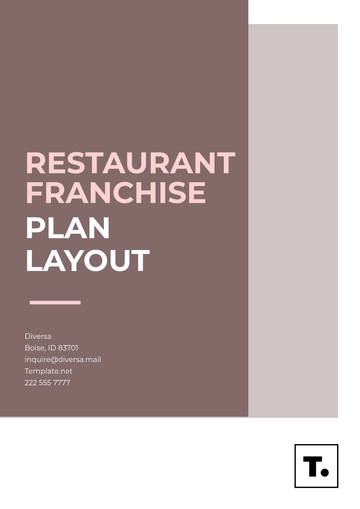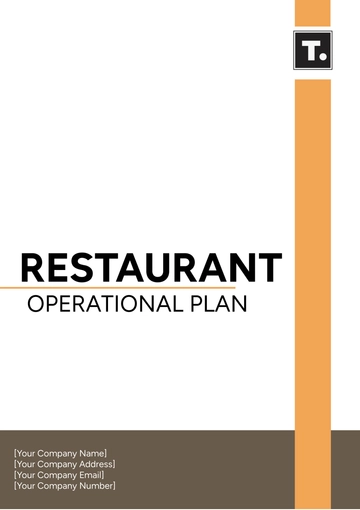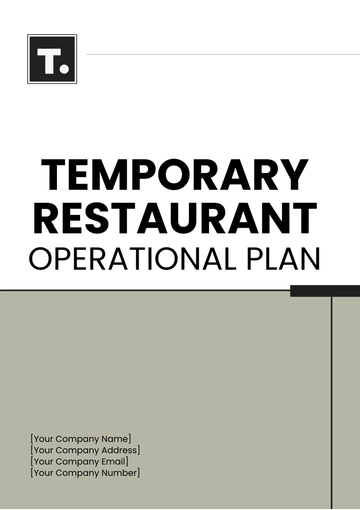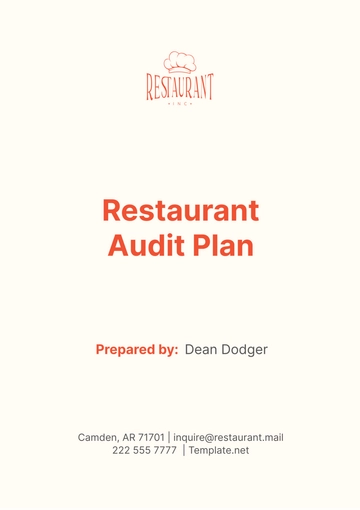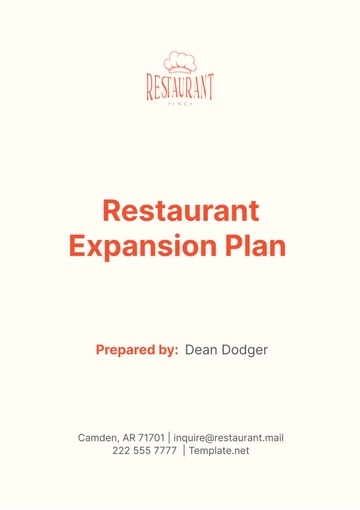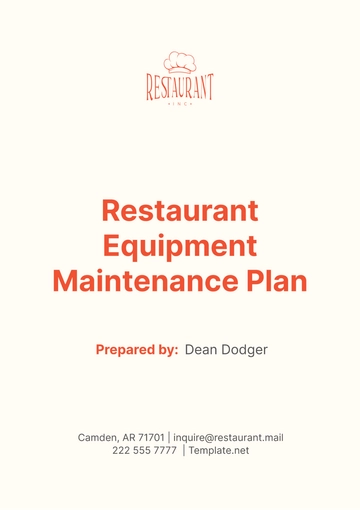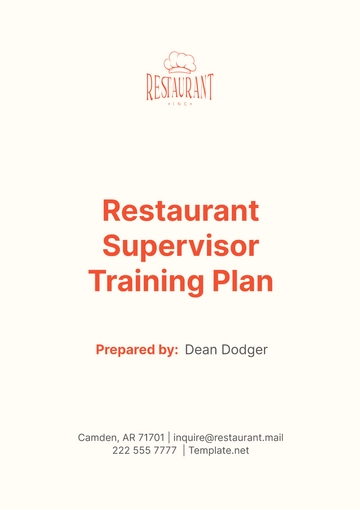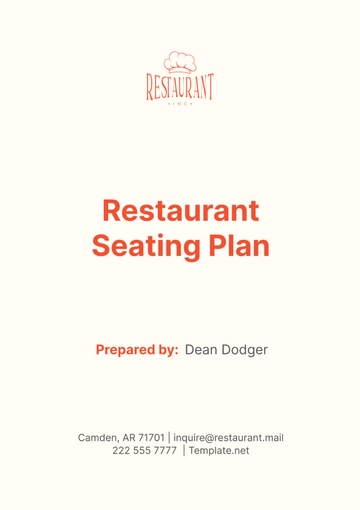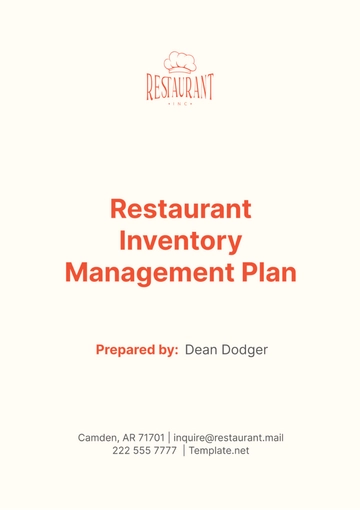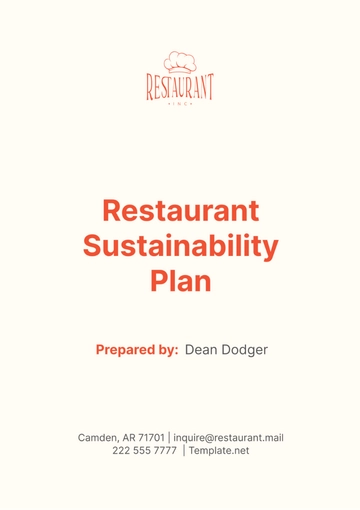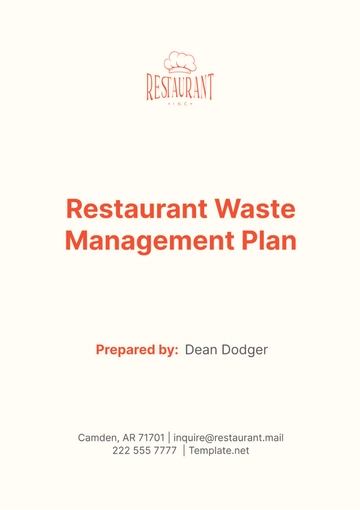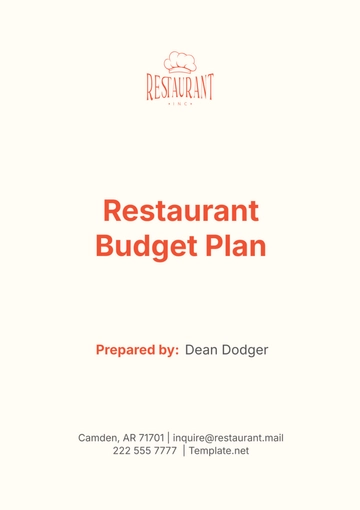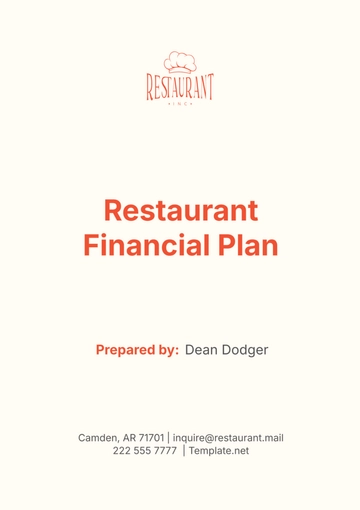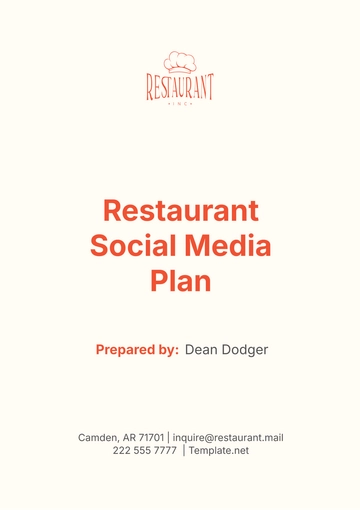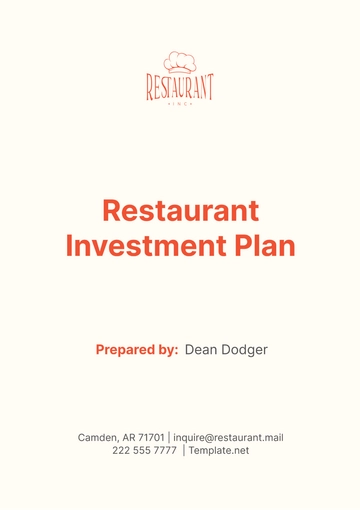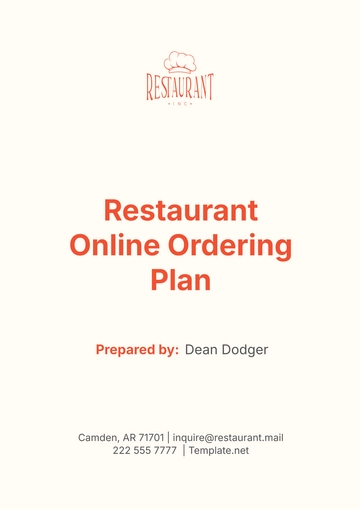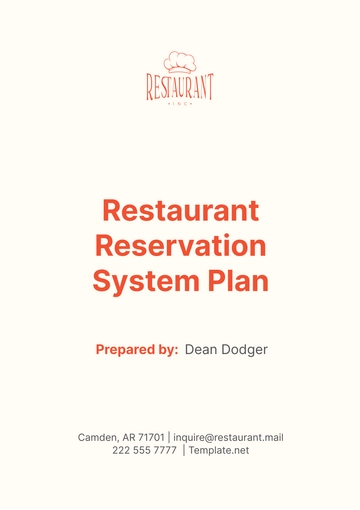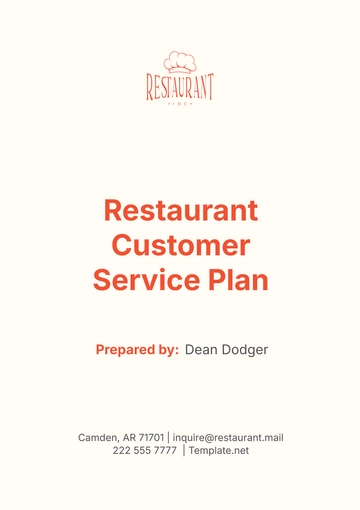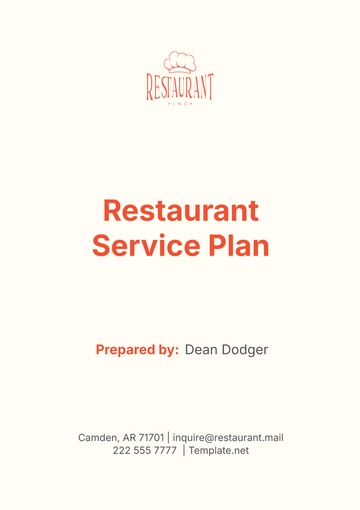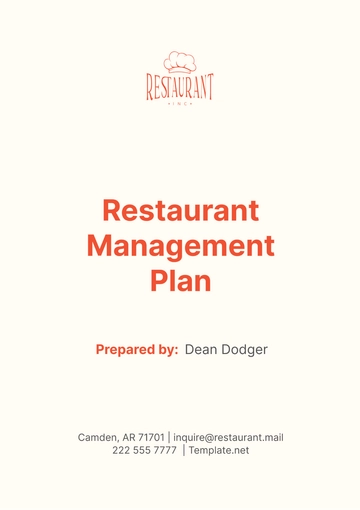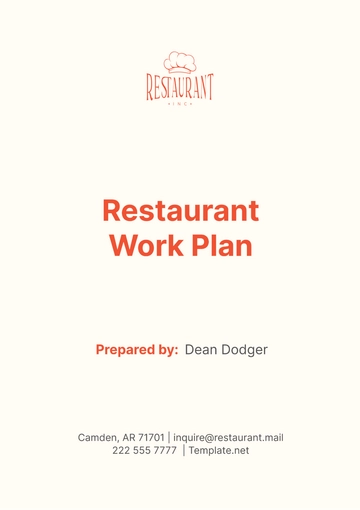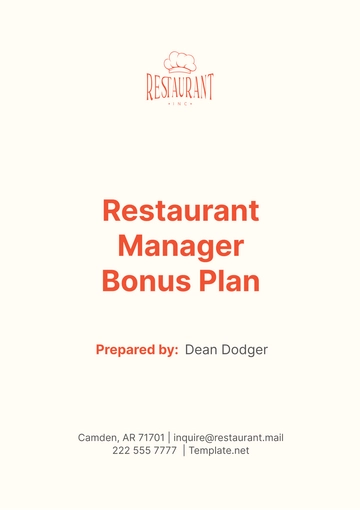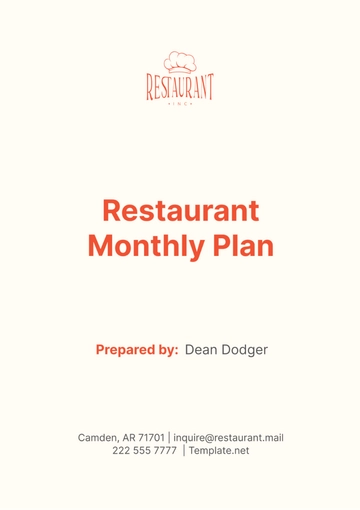Free Restaurant Expansion Plan
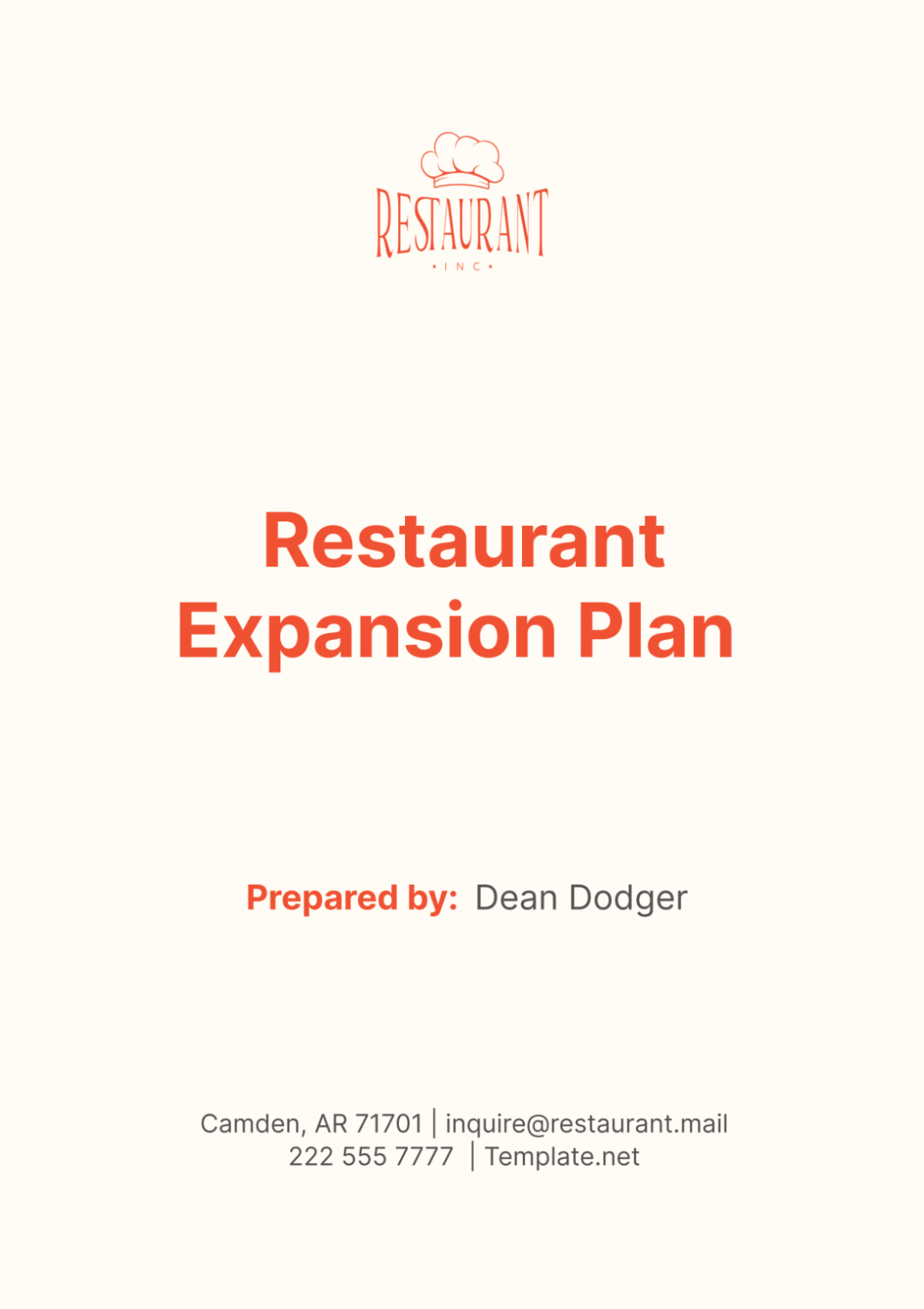
I. Executive Summary
A. Overview of Current Operations
[Your Company Name] is a renowned restaurant known for its exceptional culinary offerings and outstanding customer service. Established in [Year], we have built a strong reputation for our unique dining experience, combining high-quality ingredients with innovative recipes. Our current location in [Your Company Address] has become a staple in the community, consistently receiving excellent reviews and a loyal customer base.
With a seating capacity of 150 and a staff of 50, our restaurant operates at a full capacity, especially during peak hours. Our menu features a diverse range of dishes, catering to various dietary preferences and ensuring that there is something for everyone. Over the past year, our sales have increased by 20%, demonstrating strong growth and demand for our offerings.
B. Expansion Goals and Objectives
The primary objective of our expansion plan is to extend our reach to new markets, capitalizing on our brand's popularity and success. By opening new locations, we aim to increase our market share, enhance our brand recognition, and achieve sustainable growth.
Our key objectives include:
Opening three new locations within the next two years.
Achieving a 25% increase in annual revenue from the new locations.
Maintaining the high standards of quality and service that our brand is known for.
Building a strong presence in strategic markets to ensure long-term success.
C. Summary of the Expansion Plan
This expansion plan outlines a comprehensive strategy to open new restaurant locations in New York City, Los Angeles, and Chicago. It includes detailed market analysis, site selection criteria, marketing strategies, operational plans, financial projections, and risk management strategies. By following this plan, [Your Company Name] aims to successfully establish new locations that will contribute to the overall growth and success of the business.
II. Market Analysis
A. Industry Overview
The restaurant industry is experiencing robust growth, driven by increasing consumer demand for dining out and the rising trend of food tourism. According to [Industry Report Source], the global restaurant industry is projected to reach $4.2 trillion by 2025, with a compound annual growth rate (CAGR) of 4.7%. This growth is fueled by factors such as urbanization, rising disposable incomes, and changing consumer preferences.
The current market trend indicates a shift towards experiential dining, where consumers seek unique and memorable dining experiences. Additionally, there is a growing demand for healthy, sustainable, and locally sourced ingredients, which aligns with our restaurant's ethos.
B. Target Market Identification
To ensure the success of our expansion, it is crucial to identify and understand our target market. Our target demographic includes:
Age Group: 25-45 years old
Income Level: Middle to high-income
Lifestyle: Health-conscious, food enthusiasts, and individuals seeking unique dining experiences
Geographically, we will focus on urban areas with high population density and significant foot traffic. Our target markets include:
City A: Known for its vibrant culinary scene and high disposable income population.
City B: A rapidly growing urban area with a diverse population and a thriving food culture.
City C: A popular tourist destination with a high influx of visitors seeking unique dining experiences.
C. Competitive Analysis
Understanding the competitive landscape is essential for positioning our new locations effectively. We conducted a thorough analysis of competitors in each target market, identifying key players, their strengths and weaknesses, and market opportunities.
Competitor | Strengths | Weaknesses | Opportunities |
|---|---|---|---|
Competitor 1 | Established brand, high customer loyalty | Limited menu variety | Differentiation through diverse menu offerings |
Competitor 2 | Prime location, strong marketing presence | High prices | Competitive pricing strategies |
Competitor 3 | Unique concept, strong social media presence | Limited seating capacity | Expanding seating and enhancing customer experience |
Our SWOT analysis further highlights our position in the market:
Strengths: Strong brand reputation, diverse menu, high-quality ingredients, excellent customer service.
Weaknesses: Limited locations, and higher operational costs.
Opportunities: Expansion into new markets, leveraging brand reputation, tapping into growing consumer trends.
Threats: Intense competition, economic downturns, changing consumer preferences.
III. Site Selection and Development
A. Criteria for Site Selection
Selecting the right location is critical to the success of our new restaurants. We have established the following criteria for site selection:
Visibility: High visibility from main roads and thoroughfares.
Accessibility: Easy access for both pedestrians and vehicles, with ample parking facilities.
Foot Traffic: Locations with significant foot traffic, particularly in commercial and entertainment districts.
Space Requirements: Adequate space to accommodate a seating capacity of 150-200 guests, with additional space for kitchen and storage.
B. Real Estate Analysis
To ensure we secure the best locations, we conducted a comprehensive real estate analysis in each target market. This analysis included evaluating market conditions, property availability, and cost considerations.
City | Average Rental Rate (per sq. ft.) | Property Availability | Cost Analysis |
|---|---|---|---|
City A | $50 | High | Competitive market, premium locations |
City B | $40 | Moderate | A balance between cost and availability |
City C | $45 | High | Tourist-heavy areas, higher costs |
C. Design and Construction Plan
Once the sites are selected, we will proceed with the design and construction phase. Our architectural design will reflect the brand's identity while ensuring a comfortable and inviting atmosphere. The interior layout will maximize space efficiency, with a focus on customer experience and operational workflows.
The construction timeline will be structured as follows:
Phase 1: Site acquisition and initial design (3 months)
Phase 2: Permitting and approvals (2 months)
Phase 3: Construction and interior fit-out (6 months)
Phase 4: Final inspections and staff training (1 month)
IV. Marketing and Branding Strategy
A. Brand Positioning and Messaging
Our brand positioning revolves around offering a unique dining experience that combines exceptional food quality with outstanding service. Our messaging will emphasize our commitment to using high-quality, locally sourced ingredients and providing an unparalleled dining experience.
Key brand messages:
"Experience culinary excellence with every bite."
"Savor the taste of quality and freshness."
"A dining experience like no other."
B. Marketing Campaigns and Channels
To create awareness and attract customers to our new locations, we will implement a comprehensive marketing strategy leveraging various channels:
Digital Marketing:
Website: Optimize our website for SEO to drive organic traffic.
Social Media: Utilize platforms like Instagram, Facebook, and Twitter to engage with customers, share updates, and promote special events.
Email Marketing: Send targeted email campaigns to our existing customer base and new subscribers.
Advertising and Promotions:
Local Media: Advertise in local newspapers, magazines, and radio stations.
Online Ads: Use Google Ads and social media ads to reach a broader audience.
Promotional Events: Host grand opening events, offer limited-time discounts, and collaborate with local influencers.
C. Public Relations and Community Engagement
Building strong relationships with the community is vital for the success of our new locations. Our PR and community engagement strategies will include:
Press Releases: Announce our new openings and share our story with local media.
Community Events: Participate in local festivals, sponsor events, and host charity dinners.
Partnerships: Collaborate with local businesses and organizations to foster community ties.
V. Operations Plan
A. Staffing and Training
Recruiting and training a competent team is crucial to maintaining our high standards. Our staffing strategy will focus on hiring experienced professionals who align with our brand values.
Recruitment Strategy:
Job Fairs: Participate in local job fairs to attract potential candidates.
Online Job Portals: Post job openings on popular job search websites.
Employee Referrals: Encourage existing employees to refer qualified candidates.
Staffing Levels:
Management: 1 General Manager, 2 Assistant Managers
Kitchen Staff: 1 Head Chef, 3 Sous Chefs, 10 Line Cooks
Service Staff: 20 Waitstaff, 5 Bartenders, 5 Hosts/Hostesses
Training Programs:
Orientation: Introduce new hires to the company's culture, values, and expectations.
Skill Development: Provide comprehensive training on food preparation, customer service, and operational procedures.
Ongoing Training: Regular workshops and training sessions to keep staff updated on new menu items and best practices.
B. Menu Development
Adapting our menu to cater to the new markets while maintaining our core offerings is essential. We will introduce regional specialties and seasonal dishes to appeal to local tastes.
Core Menu: Our signature dishes that define our brand.
Regional Specials: Dishes inspired by local cuisine and ingredients.
Seasonal Offerings: Menu items that highlight seasonal produce and flavors.
We will also establish partnerships with local suppliers to ensure a consistent supply of fresh ingredients, supporting our commitment to quality and sustainability.
C. Technology and Systems
Implementing advanced technology and systems will streamline our operations and enhance the customer experience.
Point of Sale (POS) Systems: Modern POS systems to manage orders, track inventory, and process payments efficiently.
Reservation Systems: Online reservation platforms to facilitate easy booking for customers.
Customer Relationship Management (CRM): Tools to manage customer data, preferences, and feedback.
Our operational workflows will be designed to maximize efficiency, ensuring that our staff can deliver high-quality service consistently. Regular reviews and updates to these workflows will help us adapt to changing needs and improve overall performance.
VI. Financial Projections
A. Startup Costs
The startup costs for expanding [Your Company Name] to three new locations are substantial, covering expenses such as property acquisition, renovation, equipment purchase, initial inventory, and marketing. We have meticulously detailed these costs to ensure a clear understanding of the financial commitment required.
Expense Category | Estimated Cost (per location) | Total Cost (3 locations) |
|---|---|---|
Property Acquisition/Lease | $500,000 | $1,500,000 |
Renovation and Construction | $300,000 | $900,000 |
Equipment and Furnishings | $200,000 | $600,000 |
Initial Inventory | $50,000 | $150,000 |
Marketing and Advertising | $75,000 | $225,000 |
Licensing and Permits | $25,000 | $75,000 |
Staffing and Training | $100,000 | $300,000 |
Miscellaneous | $50,000 | $150,000 |
Total Startup Costs | $1,300,000 | $3,900,000 |
This table provides a comprehensive overview of the investment required for our expansion. The total startup costs amount to $3,900,000, which will be funded through a combination of internal reserves, bank loans, and potential investors.
B. Revenue and Expense Forecast
Accurate revenue and expense forecasts are crucial for assessing the financial viability of our expansion. The following table outlines our projections for the first three years of operations at each new location.
Financial Metric | Year 1 | Year 2 | Year 3 |
|---|---|---|---|
Revenue | $2,000,000 | $2,500,000 | $3,000,000 |
Cost of Goods Sold | $700,000 | $875,000 | $1,050,000 |
Gross Profit | $1,300,000 | $1,625,000 | $1,950,000 |
Operating Expenses | $1,000,000 | $1,050,000 | $1,100,000 |
Net Profit | $300,000 | $575,000 | $850,000 |
We anticipate a steady increase in revenue as the new locations establish themselves in their respective markets. Our revenue projections for the first year are conservative, taking into account the initial period of building customer awareness and loyalty. By the third year, we expect each location to generate $3,000,000 in revenue, with a net profit of $850,000.
C. Profit and Loss Analysis
A detailed profit and loss analysis helps us understand the financial health of the new locations and make informed decisions.
Income Statement | Year 1 | Year 2 | Year 3 |
|---|---|---|---|
Revenue | $2,000,000 | $2,500,000 | $3,000,000 |
Expenses | |||
- COGS | $700,000 | $875,000 | $1,050,000 |
- Salaries and Wages | $400,000 | $420,000 | $440,000 |
- Rent | $200,000 | $200,000 | $200,000 |
- Utilities | $50,000 | $52,000 | $54,000 |
- Marketing | $75,000 | $60,000 | $50,000 |
- Miscellaneous | $275,000 | $298,000 | $316,000 |
Total Expenses | $1,700,000 | $1,905,000 | $2,110,000 |
Net Profit Before Tax | $300,000 | $595,000 | $890,000 |
- Taxes | $90,000 | $178,500 | $267,000 |
Net Profit | $210,000 | $416,500 | $623,000 |
Our profit and loss analysis projects a steady growth in net profit, with significant increases in the second and third years as operational efficiencies improve and customer loyalty strengthens.
VII. Risk Management
A. Identifying Potential Risks
Understanding and mitigating potential risks is essential for the success of our expansion. The primary risks identified include market risks, operational risks, and financial risks.
Market Risks:
Economic downturns affect consumer spending.
Increased competition in the new markets.
Changes in consumer preferences.
Operational Risks:
Supply chain disruptions.
Staffing challenges, including hiring and retention.
Regulatory compliance issues.
Financial Risks:
Higher-than-expected startup costs.
Revenue shortfalls during the initial months.
Cash flow management challenges.
B. Mitigation Strategies
To address these risks, we have developed comprehensive mitigation strategies:
Market Risks:
Diversify marketing strategies to reach a broader audience.
Continuously monitor market trends and adjust offerings accordingly.
Build strong relationships with local suppliers to ensure consistency.
Operational Risks:
Establish multiple supplier agreements to avoid supply chain disruptions.
Implement robust training programs to improve staff retention.
Regularly review and update compliance procedures.
Financial Risks:
Secure sufficient funding to cover potential cost overruns.
Implement a conservative revenue forecast and maintain a cash reserve.
Monitor financial performance closely and adjust strategies as needed.
C. Ongoing Monitoring and Adjustment
Effective risk management requires ongoing monitoring and adjustment. We will implement the following measures:
Regular Reviews: Conduct quarterly reviews of financial performance, market conditions, and operational efficiency.
Key Performance Indicators (KPIs): Track KPIs such as revenue growth, profit margins, customer satisfaction, and staff turnover.
Feedback Mechanisms: Collect feedback from customers and staff to identify areas for improvement.
By proactively managing risks and continuously monitoring our performance, we can ensure the success of our expansion and the long-term sustainability of [Your Company Name].
VIII. Implementation Timeline
A. Phased Implementation Plan
A phased implementation plan will allow us to manage the expansion process efficiently, ensuring that each stage is completed on time and within budget.
Phase | Activities | Timeline |
|---|---|---|
Phase 1 | Site selection and acquisition | Months 1-3 |
Phase 2 | Design and planning | Months 4-6 |
Phase 3 | Permitting and approvals | Months 7-8 |
Phase 4 | Construction and renovation | Months 9-14 |
Phase 5 | Recruitment and training | Months 12-14 |
Phase 6 | Marketing and pre-launch activities | Months 13-15 |
Phase 7 | Grand opening and initial operations | Month 16 |
Phase 8 | Post-launch review and adjustments | Months 17-18 |
This timeline outlines a structured approach to our expansion, ensuring that all necessary activities are completed in a logical sequence.
B. Responsibility Assignment
Clearly defining roles and responsibilities is essential for effective project management. The following table outlines the key responsibilities for each phase of the implementation plan.
Phase | Responsible Party |
|---|---|
Site selection | Real Estate Manager |
Design and planning | Project Manager, Architect |
Permitting | Legal Team, Project Manager |
Construction | Contractor, Project Manager |
Recruitment | HR Manager, General Manager |
Marketing | Marketing Director, PR Manager |
Grand opening | Operations Manager, General Manager |
Post-launch review | Executive Team, General Manager |
C. Monitoring and Evaluation
To ensure that the implementation stays on track, we will employ the following monitoring and evaluation methods:
Regular Progress Meetings: Weekly meetings to review progress and address any issues.
Milestone Reports: Detailed reports at the completion of each phase.
Performance Metrics: Tracking metrics such as completion time, budget adherence, and quality standards.
By maintaining a structured approach and regularly monitoring progress, we can ensure that our expansion is executed efficiently and effectively.
IX. Conclusion
A. Summary of Key Points
In summary, [Your Company Name]'s expansion plan is a comprehensive strategy designed to capitalize on our brand's success and extend our reach to new markets. The plan includes detailed market analysis, site selection criteria, marketing strategies, operational plans, financial projections, and risk management strategies.
Key points include:
Expansion Goals: Opening three new locations within the next two years, with a 25% increase in annual revenue.
Market Analysis: Identifying target markets with high growth potential and favorable competitive landscapes.
Site Selection: Criteria focused on visibility, accessibility, foot traffic, and space requirements.
Marketing Strategy: Leveraging digital marketing, local advertising, and community engagement to attract customers.
Operational Plan: Recruiting and training staff, developing a diverse menu, and implementing advanced technology.
Financial Projections: Detailed startup costs, revenue and expense forecasts, and profit and loss analysis.
Risk Management: Identifying potential risks and implementing mitigation strategies.
Implementation Timeline: Phased plan with clearly defined roles and responsibilities.
B. Long-Term Vision
The successful execution of this expansion plan will position [Your Company Name] as a leading brand in the restaurant industry, known for its exceptional dining experience and commitment to quality. Our long-term vision includes further expansion into additional markets, continuously innovating our menu offerings, and maintaining our reputation for excellence.
By staying true to our core values and strategically managing our growth, we aim to achieve sustainable success and create lasting value for our customers, employees, and stakeholders.
C. Call to Action
We are excited about the opportunities that lie ahead and are confident in our ability to execute this expansion plan successfully. We invite our stakeholders, investors, and team members to join us on this journey as we take [Your Company Name] to new heights.
Together, we can achieve our vision of becoming a premier dining destination, delivering exceptional culinary experiences, and creating a positive impact in the communities we serve.
- 100% Customizable, free editor
- Access 1 Million+ Templates, photo’s & graphics
- Download or share as a template
- Click and replace photos, graphics, text, backgrounds
- Resize, crop, AI write & more
- Access advanced editor
Plan your growth with Template.net's Restaurant Expansion Plan Template. This customizable and editable template, accessible through the Ai Editor Tool, helps you outline your expansion strategy. Personalize it to detail objectives, timelines, and resources. Develop a comprehensive expansion plan to guide your restaurant’s growth, attract investors, and ensure successful new ventures.
You may also like
- Finance Plan
- Construction Plan
- Sales Plan
- Development Plan
- Career Plan
- Budget Plan
- HR Plan
- Education Plan
- Transition Plan
- Work Plan
- Training Plan
- Communication Plan
- Operation Plan
- Health And Safety Plan
- Strategy Plan
- Professional Development Plan
- Advertising Plan
- Risk Management Plan
- Restaurant Plan
- School Plan
- Nursing Home Patient Care Plan
- Nursing Care Plan
- Plan Event
- Startup Plan
- Social Media Plan
- Staffing Plan
- Annual Plan
- Content Plan
- Payment Plan
- Implementation Plan
- Hotel Plan
- Workout Plan
- Accounting Plan
- Campaign Plan
- Essay Plan
- 30 60 90 Day Plan
- Research Plan
- Recruitment Plan
- 90 Day Plan
- Quarterly Plan
- Emergency Plan
- 5 Year Plan
- Gym Plan
- Personal Plan
- IT and Software Plan
- Treatment Plan
- Real Estate Plan
- Law Firm Plan
- Healthcare Plan
- Improvement Plan
- Media Plan
- 5 Year Business Plan
- Learning Plan
- Marketing Campaign Plan
- Travel Agency Plan
- Cleaning Services Plan
- Interior Design Plan
- Performance Plan
- PR Plan
- Birth Plan
- Life Plan
- SEO Plan
- Disaster Recovery Plan
- Continuity Plan
- Launch Plan
- Legal Plan
- Behavior Plan
- Performance Improvement Plan
- Salon Plan
- Security Plan
- Security Management Plan
- Employee Development Plan
- Quality Plan
- Service Improvement Plan
- Growth Plan
- Incident Response Plan
- Basketball Plan
- Emergency Action Plan
- Product Launch Plan
- Spa Plan
- Employee Training Plan
- Data Analysis Plan
- Employee Action Plan
- Territory Plan
- Audit Plan
- Classroom Plan
- Activity Plan
- Parenting Plan
- Care Plan
- Project Execution Plan
- Exercise Plan
- Internship Plan
- Software Development Plan
- Continuous Improvement Plan
- Leave Plan
- 90 Day Sales Plan
- Advertising Agency Plan
- Employee Transition Plan
- Smart Action Plan
- Workplace Safety Plan
- Behavior Change Plan
- Contingency Plan
- Continuity of Operations Plan
- Health Plan
- Quality Control Plan
- Self Plan
- Sports Development Plan
- Change Management Plan
- Ecommerce Plan
- Personal Financial Plan
- Process Improvement Plan
- 30-60-90 Day Sales Plan
- Crisis Management Plan
- Engagement Plan
- Execution Plan
- Pandemic Plan
- Quality Assurance Plan
- Service Continuity Plan
- Agile Project Plan
- Fundraising Plan
- Job Transition Plan
- Asset Maintenance Plan
- Maintenance Plan
- Software Test Plan
- Staff Training and Development Plan
- 3 Year Plan
- Brand Activation Plan
- Release Plan
- Resource Plan
- Risk Mitigation Plan
- Teacher Plan
- 30 60 90 Day Plan for New Manager
- Food Safety Plan
- Food Truck Plan
- Hiring Plan
- Quality Management Plan
- Wellness Plan
- Behavior Intervention Plan
- Bonus Plan
- Investment Plan
- Maternity Leave Plan
- Pandemic Response Plan
- Succession Planning
- Coaching Plan
- Configuration Management Plan
- Remote Work Plan
- Self Care Plan
- Teaching Plan
- 100-Day Plan
- HACCP Plan
- Student Plan
- Sustainability Plan
- 30 60 90 Day Plan for Interview
- Access Plan
- Site Specific Safety Plan
